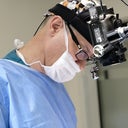There are lots of different kinds of grafts-- we'd want to know whether what we see at the tip of your nose is graft material, or how your natural cartilages were handled during the operation. In general, though, the task is to see what's causing the nose to look unnatural, figure out what to change to get it better, and make a surgical plan that's as predictable as possible. What I see most are how the tip seems to draw attention, and that dent in the tip, and the whole lower half of the nose seems wide-ish, and you didn't post profile or near-profile photos, but it looks as though the tip could be elevated as well.




